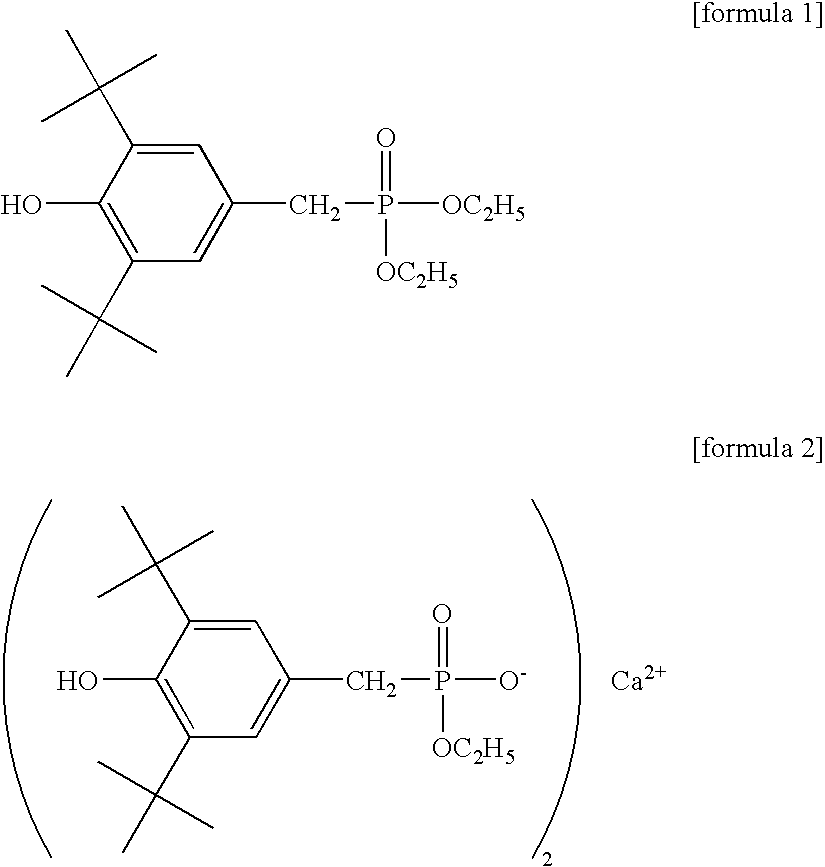Polymerization catalyst for polyester, polyester produced with the same, and process for producing polyester
a polymerization catalyst and polyester technology, applied in the direction of organic compound/hydride/coordination complex catalyst, physical/chemical process catalyst, chemical apparatus and process, etc., can solve the problems of affecting the reaction rate of polyester, affecting the reaction efficiency of polyester, so as to reduce the hydrolytic stability, the reaction rate can be increased, and the effect of reducing the thermal stability
- Summary
- Abstract
- Description
- Claims
- Application Information
AI Technical Summary
Benefits of technology
Problems solved by technology
Method used
Image
Examples
example 1
[0196]To a mixture of bis(2-hydroxyethyl)terephthalate and oligomers produced in a usual manner from high-purity terephthalic acid and ethylene glycol were added 13 g / l aluminum chloride as a polycondensation catalyst in ethylene glycol in an amount of 0.015 mol-% in terms of aluminum atom relative to the acid component in the polyester and 10 g / l Irganox 1425 (Ciba Specialty Chemicals Inc.) in ethylene glycol in an amount of 0.02 mol-% in terms of Irganox 1425 relative to the acid component, and the mixture was stirred at 245° C. for 10 minutes in a nitrogen atmosphere at normal pressure. Then, the temperature was increased to 275° C. over 50 minutes while the pressure in the reaction system was gradually reduced to 13.3 Pa (0.1 Torr), and the polycondensation reaction was further conducted at 275° C. at 13.3 Pa.
[0197]The polyethylene terephthalate (PET) having an IV of 0.65 dl / g, obtained in the polycondensation described above, was formed in a usual manner into chips. Measurement...
examples 2 and 3
[0200]PET was prepared in the same manner as in Example 1 except that the type of the catalyst used was changed. Evaluation was also conducted in the same manner as in Example 1. The composition of the catalyst used and evaluation results are shown in Table 1. A catalyst component lithium acetate.2H2O was added in the form of 50 g / l solution in ethylene glycol in the amount shown in Table 1, which is expressed in terms of lithium atom relative to the acid component in PET.
example 4
[0205]A heat transfer medium-circulating 2-L stainless steel autoclave equipped with a stirrer was charged with high-purity terephthalic acid and ethylene glycol in the molar ratio of 1:2, and triethylamine was added in an amount of 0.3 mol-% relative to the acid component, and the mixture was subjected to esterification reaction for 110 minutes at a pressure of 0.25 MPa at 250° C. while water was distilled away from the system, whereby a mixture of bis(2-hydroxyethyl)terephthalate (BHET) and oligomers (referred to hereinafter as BHET mixture) having a degree of esterification of 95% or more was obtained. To this BHET mixture were added 2.5 g / l aluminum acetylacetonate as a polycondensation catalyst in ethylene glycol in an amount of 0.014 mol-% in terms of aluminum atom relative to the acid component in the polyester and 100 g / l Irganox 1425 (Ciba Specialty Chemicals Inc.) in ethylene glycol in an amount of 0.01 mol-% in terms of Irganox 1425 relative to the acid component, and the...
PUM
| Property | Measurement | Unit |
|---|---|---|
| pressure | aaaaa | aaaaa |
| diameter | aaaaa | aaaaa |
| length | aaaaa | aaaaa |
Abstract
Description
Claims
Application Information
 Login to View More
Login to View More - R&D
- Intellectual Property
- Life Sciences
- Materials
- Tech Scout
- Unparalleled Data Quality
- Higher Quality Content
- 60% Fewer Hallucinations
Browse by: Latest US Patents, China's latest patents, Technical Efficacy Thesaurus, Application Domain, Technology Topic, Popular Technical Reports.
© 2025 PatSnap. All rights reserved.Legal|Privacy policy|Modern Slavery Act Transparency Statement|Sitemap|About US| Contact US: help@patsnap.com



